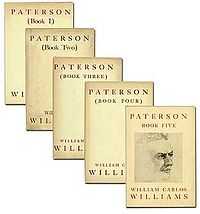Paterson (poem)

Paterson is a poem by influential modern American poet William Carlos Williams.
The poem is composed of five books and a fragment of a sixth book. The five books of Paterson were published separately in 1946, 1948, 1949, 1951, and 1958, and the entire work was published as a unit in 1963. This book is considered to be Williams' epic. Williams' book In the American Grain is claimed to be Paterson's abstracted introduction involving a rewritten American history. Paterson itself is a poetic monument to, and personification of, the city of Paterson, New Jersey. One of the least opaque themes of the poem centers on the process of industrialization and its effects. But Randall Jarrell opines that "the [true] subject of Paterson is: How can you tell the truth about things?--that is, how can you find a language so close to the world that the world can be represented and understood in it?"[1] One notable phrase that echoes this theme and is repeated throughout the poem is, "No ideas but in things."[2]Composition
Williams saw the poet as a type of reporter who relays the news of the world to the people. He prepared for the writing of Paterson in this way:
I started to make trips to the area. I walked around the streets; I went on Sundays in summer when the people were using the park, and I listened to their conversation as much as I could. I saw whatever they did, and made it part of the poem.[3]The Poetry Foundation's biography on Williams notes the following source:
With roots in his [short] 1926 poem [also entitled] "Paterson," Williams took the city as "my 'case' to work up. It called for a poetry such as I did not know, it was my duty to discover or make such a context on the 'thought'."[4]
While writing the poem, Williams struggled to find ways to incorporate the real world facts obtained during his research in preparation for its writing. On a worksheet for the poem, he wrote, "Make it factual (as the Life is factual-almost casual-always sensual-usually visual: related to thought)". Williams considered, but ultimately rejected, putting footnotes into the work describing some facts. Still, the style of the poem allowed for many opportunities to incorporate 'factual information', including portions of his own correspondence with the American poet Marcia Nardi and fellow New Jersey poet Allen Ginsberg as well as historical letters and articles concerning figures from Paterson's past (like Sam Patch and Mrs. Cumming) that figure thematically into the poem.[5]
Response
The Poetry Foundation biography on Williams notes the following critical response to Williams' Modernist epic:[Williams biographer James] Breslin reported "reception of the poem never exactly realized his hopes for it." Paterson's mosaic structure, its subject matter, and its alternating passages of poetry and prose helped fuel criticism about its difficulty and its looseness of organization. In the process of calling Paterson an "'Ars Poetica' for contemporary America," Dudley Fitts complained, "it is a pity that those who might benefit most from it will inevitably be put off by its obscurities and difficulties." Breslin, meanwhile, accounted for the poem's obliqueness by saying, "Paterson has a thickness of texture, a multi-dimensional quality that makes reading it a difficult but intense experience."[6]Poet/critic Randall Jarrell praised Book I of the poem with following assessment:
Paterson (Book I) seems to me the best thing William Carlos Williams has ever written. . .the organization of Paterson is musical to an almost unprecedented degree. . . how wonderful and unlikely that this extraordinary mixture of the most delicate lyricism of perception and feeling with the hardest and homeliest actuality should ever have come into being! There has never been a poem more American.[1]However, Jarrell was greatly disappointed with Books II, III, and IV of the poem, writing the following:
Paterson has been getting rather steadily worse [with each subsequent Book]... All three later books are worse organized, more eccentric and idiosyncratic, more self-indulgent, than the first. And yet that is not the point, the real point: the poetry, the lyric rightness, the queer wit, the improbable and dazzling perfection of so much of Book I have disappeared--or at least, reappear only fitfully.[1]
Awards
The U.S. National Book Award was reestablished in 1950 with awards by the book industry to authors of 1949 books in three categories. William Carlos Williams won the first National Book Award for Poetry, evidently recognizing both the third volume of Paterson and Selected Poems.[7]
References
- ↑ 1.0 1.1 1.2 Jarrell, Randall. "Paterson by William Carlos Williams." No Other Book: Selected Essays. New York: HarperCollins, 1999.
- ↑ Williams, William Carlos. Paterson. New Directions, 1963.
- ↑ Bollard, Margaret Lloyd (1975). "The "Newspaper Landscape" of Williams' "Paterson"". Contemporary Literature (University of Wisconsin Press) 16 (3): 317–327. doi:10.2307/1207405. JSTOR 1207405.
- ↑ Poetry Foundation biography on Williams
- ↑ Bollard (1975), p. 320
- ↑ http://Poetry Foundation bio on Williams[www.poetryfoundation.org/bio/william-carlos-williams]
- ↑ "National Book Awards – 1950". National Book Foundation. Retrieved 2012-02-25.
(With essays by Neil Baldwin and Ross Gay from the Awards 50(?) and 60-year anniversary publications. Baldwin clearly identifies (and discusses) the second book: "The edition of the Selected Poems brought out in 1949 has of necessity over the past half-century been emended and expanded many times. ..."
| |||||||||||